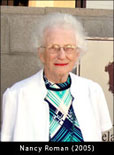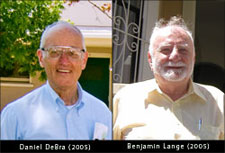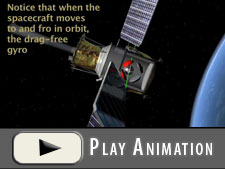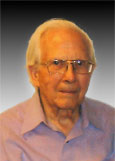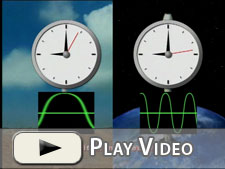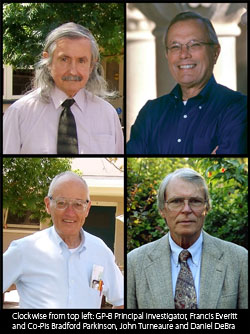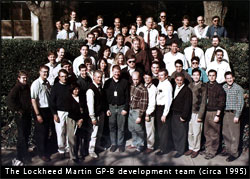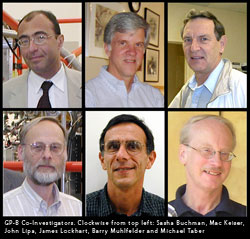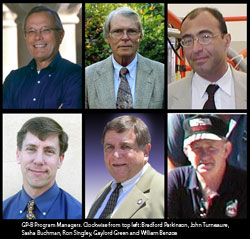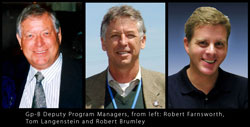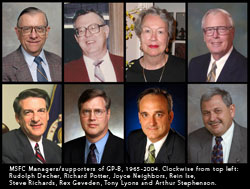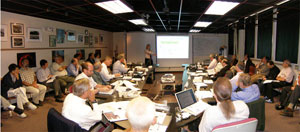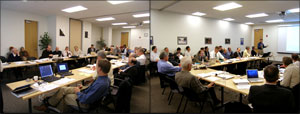History & Management
On this page:
- Origins of the Experiment
- Concept Development
- Drag-Free Satellite Development
- Stanford's Relativity Gyroscope Experiment Becomes "GP-B"
- Transition to a NASA Flight Program
- The GP-B Management Experiment
- Payload & Spacecraft Development
- Preparing the Spacecraft for Launch
- The GP-B Science Advisory Committee (SAC)
Note: You can read a more detailed and complete history of GP-B in chapters 2 and 6 of the GP-B Post-Flight Analysis—Final Report.
Origins of the Experiment
Early theoretical discussions of gyroscope tests of general relativity were given in the 1920’s by J. A. Schouten and A. S. Eddington. In the 1930’s, P. M. S. Blackett investigated the possibility of a ground-based experiment, concluding correctly that it was beyond the reach of technologies known at that time. It was not until the dawn of the space age in the late 1950s that such tests of Einstein's theory actually became feasible.
The idea of testing general relativity by means of orbiting gyroscopes was suggested independently in late 1959-early 1960 by MIT physicist George Pugh and Stanford physicist Leonard Schiff. Pugh’s Proposal for a Satellite Test of the Coriolis Prediction of General Relativity appeared in an unusual location for scientific papers: the U.S. Department of Defense Weapons Systems Evaluation Group (WSEG) Memo #11 (November, 12, 1959). Schiff’s Possible New Experimental Test of General Relativity Theory was published in the March 1, 1960 issue of Physical Review Letters.
Schiff, then chairman of the Stanford Physics Department, discussed his developing ideas with two physics department colleagues, Professors William Little and William Fairbank, both low-temperature physicists. Fairbank, in turn, had an exchange with Professor Robert Cannon, who like Fairbank had just arrived at Stanford. Cannon had considerable experience with state-of-the-art gyroscopes, and he had come to Stanford to create a Guidance and Control Laboratory in the Department of Aeronautics & Astronautics. There followed an important half-hour meeting between Fairbank, Cannon and Schiff, from which evolved the essential collaboration between the Physics and Aero-Astro departments which has been fundamental to the success of GP-B.
Schiff subsequently published a more extended paper, entitled Motion of a Gyroscope According to Einstein's Theory of Gravitation in the June 15, 1960 issue of the Proceedings of the National Academy of Sciences (Volume 46, Number 6, pp. 871-882). Pugh's proposal remained relatively unknown until 2003, when it was included in the Classical Papers section of the book, Nonlinear Gravitodynamics: The Lense-Thirring Effect, ed. R. Ruffini and C. Sigismondi, Singapore, World Scientific. An important feature of Pugh’s proposal was that it described the mechanics of a drag-compensating satellite (see the Drag-Free Satellite section below), and it proposed a number of uses for such technology, including the testing of the frame-dragging effect predicted by Einstein's general theory of relativity.
For an historical review and comparison of these papers, see C. W. F. Everitt: The Stanford Relativity Gyroscope Experiment (A): History and Overview, in the book, Near Zero: New Frontiers of Physics, ed. J. D. Fairbank et. al., New York, W. H. Freeman, 1988.
Concept Development
In the months following publication of Schiff’s expanded PNAS paper, Schiff, Fairbank and Cannon continued to develop and refine various aspects of the relativity gyroscope experiment. One early question was the feasibility of flying a reference telescope. Cannon, being familiar with NASA’s forthcoming Orbiting Astronomical Observatory (OAO) from conversations with Dr. Nancy Roman of NASA Headquarters was able to dispel this concern. In January 1961, Schiff and Fairbank sent a three-page letter proposal to NASA’s Office of Space Sciences, outlining a possible approach to the relativity gyroscope flight experiment.
During Roman’s first year at NASA, the Office of Space Sciences had received a number of proposals on space tests of general relativity, including the Stanford proposal from Schiff and Fairbank. Roman and other NASA scientists were eager to support such research; however NASA realized that evaluating these proposals required input from scientists and engineers with highly specialized knowledge in this field. At Roman’s initiative, a NASA-sponsored conference on experimental tests of relativity was held at Stanford under the chairmanship of the distinguished relativist, H. P. Robertson of Caltech, on July 20-21, 1961, with a large attendance of physicists and aerospace engineers, including Schiff and Cannon.
Also in 1961, at the meeting of the International Union of Theoretical and Applied Mechanics, Cannon presented the first engineering paper describing the planned orbital experiment: Requirements & Design for a Special Gyro for Measuring General Relativity Effects from an Astronomical Satellite, published in Kreiselprobleme Gyrodynamics, Symposium Celerina, August, 1962, ed. H. Ziegler, Berlin, Springer-Verlag.
In 1962, Fairbank met Francis Everitt, then a research associate at the University of Pennsylvania, and encouraged him to come to Stanford as the first full-time academic staff member in the relativity gyroscope experiment, some graduate student research having already begun. During this period, Fairbank and Cannon, working with Schiff as an advisor, had begun to draft a more detailed proposal to NASA in order to obtain funding for the development of a drag-free satellite in which a gyroscopic test of general relativity would be performed, among other uses. Fairbank invited Everitt to help draft this proposal, which was submitted to NASA in November 1962 with title: Proposal to Develop a Zero-G, Drag-Free Satellite and to Perform a Gyro Test of General Relativity in a Satellite, with Fairbank and Cannon as Co-Prinicpal Investigators and Schiff as Project Advisor.
Drag-Free Satellite Development
One of the many important discussions that took place during the 1961 Stanford conference on testing relativity was the need for a drag-compensated satellite—that is, a satellite that could orbit the Earth in a state of free fall, with no drag or resistance from the atmosphere or solar radiation pressure. Among the conference attendees were two of Cannon’s graduate students: Daniel DeBra, who was finishing his Ph.D. while heading up the Dynamics & Controls Analysis Group at Lockheed Missiles & Space Company (now Lockheed Martin Space Systems Company, abbreviated hereon as "LM"), and Benjamin Lange, also from LM, who was just starting his graduate studies in the Stanford Aero-Astro Department.
During the discussion following a presentation by J. Siry of NASA's Goddard Space Flight Center, C. W. Sherwin of Aerospace Corporation suggested that the motion of a satellite be "slaved" to a freely falling test object, so that the latter is always at the center of the satellite. As this discussion proceeded, Lange had an "aha moment," in which he realized that a feedback system could be used to produce this drag-compensated effect. Creating such a system became the subject of his doctoral dissertation, in which he coined the term, "drag-free satellite." Lange's Ph.D. dissertation was the first of many on the subject of drag-free technology in the Stanford Aero-Astro Department, which ultimately became the world's leading authority on drag-free technology.
DeBra, now a Professor Emeritus in Stanford’s Aero-Astro Department, has been a Co-PI on GP-B since the late 1960’s. Separately, in the early 1970s, he led the development, in collaboration with Johns Hopkins Applied Physics Laboratory, of the first drag-free satellite ever flown—the Disturbance Compensation System (DISCOS) drag-free controller for the U. S. Navy’s TRIAD transit navigation satellite, successfully launched in July 1973. It achieved 5x10-12 g.
Historical Note: As mentioned above, MIT Physicist, George Pugh, was actually the first person to propose the concept and uses of a slaved satellite—or "tender satellite," as he called it—in his November 12, 1959 U.S. Department of Defense Weapons Systems Evaluation Group (WSEG) Memo #11, Satellite Test of the Coriolis Prediction of General Relativity. For whatever reason, Pugh was not invited to attend the 1961 NASA conference on experimental tests of relativity at Stanford. Nevertheless, page iv of the conference proceedings overview, written by Schiff, acknowledged Pugh's 1959 description of a tender satellite, and Schiff cited Pugh's 1959 proposal in his two 1960 publications on testing relativity with gyroscopes in space, as well as in many subsequent publications and proposals on this topic. However, although Cannon and his students (Lange and others) were aware of Pugh's 1959 proposal due to Schiff's references to it, none of them actually saw or read it until 1990—long after the Stanford Aero-Astro group had pioneered and become the world's leading authority on drag-free technology. Apparently, Francis Everitt was the first GP-B team member, other than Schiff, to actually read Pugh's proposal. In 1989, after giving a talk on GP-B at Clemson College, a physicist there gave Everitt a copy. After reading it, Everitt contacted Pugh and congratulated him on being the originator of the drag-free satellite concept. Furthermore, Everitt invited Pugh to attend a birthday celebration for Dan DeBra in July 1990, during which Pugh gave a talk to the entire GP-B team about his 1959 memo and his ideas on drag-free satellites and their use in testing general relativity. Thus, in 1990, Pugh's proposal was finally distributed to and read by other members of the GP-B team. Everitt also arranged for Pugh's proposal to be reprinted in the book, Nonlinear Gravitodynamics: The Lense-Thirring Effect, R. Ruffini and C. Sigismondi editors, 2003.
See also: The Full Realization of the Drag-Free Satellite in the Technology—Payload & Spacecraft section.
Learn more about drag-free satellites:
- View a PDF of George Pugh's 1959 memo entitled, Satellite Test of the Coriolis Prediction of General Relativity,in which the concept of a drag-free satellite was first proposed.
- View a PDF of Cannon, Fairbank & Schiff's Proposal to Develop a Zero-G, Drag-Free Satellite and to Perform a Gyro Test of General Relativity in a Satellite, submitted to NASA in November 1962.
- View a PDF of Benjamin Lange's 1964 Stanford doctoral dissertation, entitled: The Control and Use of Drag-Free Satellites.
- View a PDF of Benjamin Lange's 1964 paper entitled, The Drag-Free Satellite, from the American Institute of Aeronautics & Astronautics Journal (AIAA), Volume 2, Number 9, September 1964, pp. 1590-1606.
- View a PDF of Daniel DeBra's 1974 paper entitled: A Satellite Freed of All But Gravitational Forces: "TRIAD I", from the American Institute of Aeronautics & Astronautics Journal (AIAA), Volume 11, Number 9, September 1974, pp. 637-644.
Stanford's Relativity Gyroscope Experiment Becomes "GP-B"
NASA funding of the 1962 Stanford proposal "To Build a Drag-Free Satellite and Perform a Gyro Test of General Relativity" commenced in March 1964, retroactive to November 1963, with Cannon and Fairbank as equal Co-PIs and Schiff as Project Advisor. The U.S. Air Force provided a supplemental grant. Dan DeBra joined the program at that time. In 1964 after completing his doctoral dissertation, Lange joined the faculty of the Stanford Aero-Astro Department and was appointed as third Co-PI. In 1966, Cannon left Stanford to serve as Chief Scientist for the U.S. Air Force, a position he held till 1968. DeBra was appointed Co-PI for the Aero-Astro portion in 1966, and Everitt Co-PI in the Physics portion shortly thereafter. Cannon briefly returned to Stanford in 1968; then served from 1969 to 1971 as U.S. Assistant Secretary of Transportation. Lange left Stanford in 1969. Schiff continued his role as Program Advisor until his death in 1971. The collaboration with NASA's Marshall Space Flight Center (MSFC) commenced in 1965. During these years, Stanford began the development of several technologies in collaboration with MSFC and industry.
Full-time management was transferred from NASA Headquarters to MSFC in 1971. Coincident with the transfer, C. Dixon Ashworth, the NASA HQ manager named it and the hydrogen-maser clock comparison experiment headed by Robert Vessot of the Smithsonian Astrophysical Observatory, also managed by MSFC, respectively Gravity Probe B (GP-B) and Gravity Probe A (GP-A). In December 1971, MSFC funded Ball Brothers Research Corporation (BBRC, now Ball Aerospace) to perform an in-depth "Mission Definition Study" of GP-B in collaboration with Stanford. Two further BBRC studies were performed in 1973 and 1975. They indicated GP-B was ready to make the transition from exploratory research and technology development to a NASA flight program.
Transition to a NASA Flight Program
In January 1977, the original NASA research grant to Stanford was closed out—the longest running continuous research grant ever awarded by NASA—symbolically marking the end of the exploratory phase of the program, during which much of the key technology needed was developed. In its place, NASA's Office of Space Sciences awarded a new contract for the purpose of defining a flight program. A year later, funding support at NASA Headquarters for the program switched from the Office of Space Science under Nancy Roman to the Advanced Program Development Office under Jeffrey Rosendhal.
MSFC conducted an in-house Phase A study of GP-B in preparation for defining a flight program in 1980. Later that year, under the chairmanship of Jeffrey Rosendhal at NASA Headquarters, NASA convened a special committee to assess the technological readiness of GP-B for becoming a NASA flight mission. The Rosendhal Committee concluded that:
"…the remarkable technical accomplishments of the dedicated Stanford experiment team give us confidence that, when they are combined with a strong engineering team in a flight development program, this difficult experiment can be done."
By 1981, Francis Everitt had become the single person most knowledgeable about all aspects of the GP-B experiment. For this reason, he was promoted to the job of Principal Investigator, challenged with bringing the experiment to fruition—a job that would ultimately take another 25 years to accomplish. Encouraged by the results of the 1980 Phase A study, MSFC, with support from Stanford, undertook a much more in-depth Phase B study in 1982. The Phase B study yielded a spacecraft that was too large and a program that was too expensive, with an unacceptable level of risk. Thus, in 1983, Everitt and the Stanford team, in collaboration with MSFC, undertook an extensive restructuring of the program, with a goal of reducing the weight and power requirements of the spacecraft, reducing overall costs, and reducing program risks to an acceptable level—all without sacrificing any essential science goals.
The result of this restructuring effort was a two-phase Space Shuttle mission. The first phase was to be a technology readiness demonstration called STORE (Shuttle Test of the Relativity Experiment). In this phase, the dewar and science instrument would be tested during a shuttle flight to be launched in 1989. At the end of the test, this equipment would be brought back to Earth by the shuttle, refurbished, and then integrated into a satellite for performing the actual experiment. Two years later, the GP-B satellite would be placed in orbit by a polar-orbiting Shuttle, which could be launched only from NASA's SL-6 West Coast Shuttle Launch Facility at Vandenberg AFB, in Southern California.
The GP-B Management Experiment
In 1984, GP-B began the transition from program definition to payload and spacecraft design. With the anticipated increase in staff and activity required for flight hardware design and development, Everitt recruited Bradford Parkinson (1966 Stanford Aero-Astro Ph.D. whose dissertation research on spherical gyroscopes was carried out in the early GP-B labs) to return to Stanford from private industry to serve as both a Co-PI and the first formal Program Manager of GP-B. Parkinson is credited with creating the U.S. Air Force Global Positioning System (GPS) and had previously been Program Manager for its successful deployment. To round out the new GP-B senior management team, Daniel DeBra continued as a Co-PI from the Aero-Astro Department, as did William Fairbank in the Physics Department, until his death in 1989. Furthermore, physics Professor John Turneaure was promoted to Hardware Manager (and two years later, he also became a Co-PI). A full GP-B senior management team was now in place.
For a number of reasons including the interdependency of the payload and spacecraft and the high level of technology development required, Samuel Keller, then Deputy Director of the NASA Office of Space Science Applications, decided to make Stanford NASA's prime contractor on the GP-B mission. James Beggs, then the NASA Administrator, concurred with this decision and remarked that in addition to being a physics experiment that needed to be carried out in space, GP-B was equally interesting as a “management experiment.” This was one of the first, and largest NASA missions, in which a university was given the prime role of managing the development of an entire space flight mission—science instrument, spacecraft, operations and data analysis.
Payload & Spacecraft Development
William Fairbank once remarked: “No mission could be simpler than Gravity Probe B. It's just a star, a telescope, and a spinning sphere.” However, it took the exceptional collaboration of Stanford, MSFC, Lockheed Martin and a host of others almost two more decades to finally bring this “simple” experiment to the launch pad in April 2004. As Bradford Parkinson recently noted:
“Optimism was rampant [in 1960, when GP-B began]. We didn't have any idea how hard this was, and I would contend it was probably not until 30 years later that we brought [into existence] the technology to make perfect spheres, the coating technology, the readout technology, the cryogenic technology, the [telescope] pointing technology… None of this was possible in 1960.”
NASA initiated funding of STORE in FY 1985, following receipt in November 1984 of a Stanford proposal, with LM as sub-contractor. In this proposal, Lockheed held principal responsibility for developing the unique 650-gallon dewar and probe—the cryogenic chamber that houses the telescope and four gyroscopes. However, after the Challenger disaster in 1986 and the subsequent closure of NASA's West Coast SL-6 Shuttle Launch Facility, it was necessary to re-think the mission as a satellite launch from an expendable launch vehicle, without losing the technology funding. In 1988, a new shuttle-based test of GP-B technology was proposed, designated Shuttle Test Unit (STU), and it was planned to take place in the mid-1990s. STU represented a substantial de-scoping of STORE—a room-temperature test of gyro suspension and spin-up in a micro-gravity environment. The STU experiment remained part of the GP-B plan until 1995, when flight readiness of several key components had already been demonstrated, and NASA concurred with Stanford's recommendation that a Shuttle test of the technology would no longer be necessary.
By the early 1990s, it had become apparent that regardless of whether the STU Shuttle test of GP-B technology was carried out, the final experiment would require a space vehicle (satellite) that would house the dewar and probe as an integrated system, and that a subcontractor needed to be selected to develop this space vehicle. In 1992, Stanford began a thorough, by-the-book bidding and evaluation process to select a subcontractor. Two years later, after narrowing the the field and soliciting detailed proposals from two aerospace companies—Fairchild Aerospace and Lockheed Martin—Stanford once again selected LM to build the GP-B space vehicle. The contract gave LM responsibility for acquiring and building the spacecraft subsystems, integrating the spacecraft assembly, integrating the payload with the spacecraft upon the space vehicle, performing integrated testing, supporting pre-launch operations and supporting mission operations from initialization and on-orbit checkout (IOC) through the science data collection and post-science instrument calibration phases of the flight mission.
By 1994, all of the pieces of a GP-B flight mission were at last coming together: flight-ready prototyping of the gyros, analog gyro suspension system, and gyro readout system at Stanford, development of the flight dewar and probe at LM, and the competitive selection of LM to construct the space vehicle. In the summer of 1994, Stanford and NASA signed a Program Commitment Agreement (PCA) funding Gravity Probe B as a NASA flight mission. On the joint recommendation of Stanford, MSFC, and the Office of Space Sciences at NASA Headquarters, the PCA was based on a de-scoped program, eliminating the Shuttle Test Unit (STU) and canceling the development of a third flight dewar and a fourth probe (having deemed that the second dewar and third prototype probe already in development would be satisfactory for flight), with a target launch date of October 2000.
Over this period, as construction of the payload and spacecraft was in full swing, the GP-B team expanded, reaching a peak of approximately 100 persons at Stanford, and eventually some 200 persons at Lockheed Martin. Six Stanford scientists, each with a different area of specialization, became Co-Investigators: Saps (Sasha) Buchman, George (Mac) Keiser, John Lipa, James Lockhart, Barry Muhlfelder, and Michael Taber.
In 1998, Bradford Parkinson stepped aside as Program Manager, to be succeeded first by John Turneaure, and then in turn, Sasha Buchman, Ronald Singley, and Gaylord Green for the flight program, and William Bencze for the data analysis phase of the mission. Throughout this period, Tom Langenstein served as the Deputy Program Manager, with responsibility for resources and procurements.
At NASA's Marshall Space Flight Center, Richard Potter provided guidance and support for GP-B from 1971-1993. During the last 10 years of Potter’s term as the nominal program manager for GP-B, other MSFC managers shared the management responsibilities, including Joyce Neighbors, then Rein Ise, and finally Steve Richards. From 1990-1993, GP-B management oversight transitioned from Potter to Ise, and then to Richards. Ise and Richards had joint responsibility from 1993-1995, at which time Rex Geveden took over as the first formal program manager for GP-B, a position which he held through the GP-B launch and IOC phases in 2004. Towards the end of 1995, Tony Lyons joined the GP-B program as Chief Engineer from NASA/MSFC, and he became the NASA Program Manager for GP-B in 2004 when Geveden moved to NASA Headquarters.
Preparing the Spacecraft for Launch
In 1997, GP-B began another transition—this time from an R&D program with limited NASA oversight to a classical NASA flight program that would culminate in a successful launch, on-orbit operations, and data collection. The years from 1997-2002 were primarily focused on payload integration and testing, which included integrating the gyros, SQUIDs, telescope, etc. into the Science Instrument Assembly (SIA), the SIA into the probe, and the probe into the dewar. The whole payload was then tested as a unified system. In addition, the Gyro Suspension System (GSS) and three key electronics components—the Experiment Control Unit (ECU), the SQUID Readout System (SRE) and the Telescope Readout System (TRE)—were completed in this time frame. These years represented a critical period for GP-B, in which engineering design came face-to-face with the realities of technology fabrication. Not surprisingly, some unexpected design and assembly issues began to surface during tests of the integrated payload system. Addressing these issues used up the savings in time and money gained in the 1994-95 de-scoping of the program and postponed the launch date from 2000 to 2002, then to 2003, and ultimately 2004.
For example, integrated testing of the Dewar and Probe in August 1999 revealed a thermal disconnection between a series of copper heat-conduction bands inside and outside the probe, as well as an unrelated problem with the SQUID pickup loop for gyro #4. In monitoring these issues and the resulting schedule delays required to address them, upper management at NASA Headquarters became increasingly concerned about the viability of the GP-B mission and ordered MSFC to take a much more active role in the management of GP-B. Thus began a difficult two-year period from 2000-2002, during which the three entities involved—MSFC, Stanford, and LM—had to figure out how to communicate and work together effectively and harmoniously. Each of these entities had its own “culture” and ways of doing things that were successful for each entity respectively. These differences were an advantage in the early stages of the program when innovation and technology development were most important. However, in the focused environment of meeting a launch schedule while trying to minimize the risk of failure, these three divergent cultures collided. For example, the Stanford scientists and engineers, who excelled at innovating technology, were unaccustomed to the rigorous, methodical, procedural nature of the aerospace industry. Likewise, seasoned aerospace managers were frustrated by the tendency of university researchers to continue tinkering with and perfecting technologies past a stage that would be “good enough” to meet necessary milestones in a tight schedule.
It took the exceptional insight and leadership of Rex Geveden, then NASA's GP-B Program Manager at MSFC (later to become Associate Administrator at NASA Headquarters and recently CEO of Teledyne Brown Engineering), in collaboration with Principal Investigator Francis Everitt and other senior management at Stanford, LM, and NASA to arrive at an effective collaborative plan that would ensure the readiness of the GP-B spacecraft, payload and operations team for launch and the flight mission. In 2002, Geveden implemented a risk-based oversight system, devised by Buddy Randolph, the MSFC Lead Systems Engineer for GP-B, and based on a risk management system and a 5-level insight system developed by the MSFC Engineering Directorate. Other factors also served to improve the working relationships, including the constant efforts of NASA's Resident Stanford Manager, Ed Ingraham, a communications plan negotiated and signed by Geveden, Sasha Buchman (the GP-B Program Manager at that time), and Hugh Dougherty (LM Program Manager), additional systems engineering personnel brought in by LM, and efforts by Stanford personnel— in many cases with LM support—to adopt such NASA and industry practices as risk management systems, fault tree analyses, and requirements verification. Others who contributed significantly to these efforts included LM Lead Systems Engineer Bob Schultz, LM systems Engineer Rich Whelan, and MSFC systems engineer Brian Mulac.
In contrast to earlier NASA program reviews, the GP-B Space Vehicle Acceptance Review (SVAR) in June 2003 went smoothly, and the noticeably-fewer issues raised during that meeting were closed within weeks, rather than months or even years. The entire team had clearly stepped up to the job of getting the space vehicle ready for transport to Vandenberg AFB for launch. Unfortunately, in late 2003 there was a need for one last launch delay, to April 2004. This meant one more review with NASA Headquarters to establish a new launch date. The competence of the Stanford-LM-MSFC team clearly showed, with convincing and viable plan being presented to NASA managers. The result was a smooth, non-controversial review that established April 17, 2004 as the final target launch date. The GP-B team successfully held to this schedule throughout the pre-launch processing until launch vehicle delays pushed the launch out a few more days to April 20th.
The GP-B Science Advisory Committee (SAC)
In 1998, following a recommendation from one of the NASA independent annual reviews of GP-B, Principal Investigator, Francis Everitt, in collaboration with NASA and relativistic physicist Clifford Will, formed an external GP-B Science Advisory Committee (SAC). The SAC is sponsored by and reports directly to NASA, and its purpose is to review and evaluate all aspects of the GP-B program, including the functioning of the instrument and spacecraft, possible sources of error, and the final data analysis, and then to provide advice and recommendations to NASA and GP-B to ensure the continued success of the mission.
The committee is comprised of seven distinguished scientists, with expertise in various areas of relativistic and gravitational physics, low-temperature physics, and astrophysics/cosmology:
- Clifford Will (Chair) (Washington University, St. Louis)
- David Bartlett (University of Colorado)
- Robert Reasenberg (Harvard-Smithsonian Center for Astrophysics)
- Robert Richardson (Cornell University)
- John Ries (University of Texas, Austin)
- Peter Saulson (Syracuse University)
- Edward (Ned) Wright (UCLA)
SAC Chairman Clifford Will, James S. McDonnell Professor of Physics at Washington University in St. Louis, is a world-renowned expert in relativity and gravitational physics and author of the classic text, Theory & Experiment in Gravitational Physics. Several SAC committee members are associated with other NASA and NSF missions whose results relate to GP-B, including WMAP (Wilkinson Microwave Anisotropy Probe), LIGO (The Laser Interferometer Gravitational-Wave Observatory), and GRACE (Gravity Recovery and Climate Experiment). SAC member Robert Richardson is a 1996 Nobel Laureate in low-temperature Physics.
Between 1998 and 2007, the committee has met 17 times, most recently on November 2, 2007. Further periodic meetings will be scheduled as the data analysis progresses, with an extended set of meetings planned to review the final results when the data analysis has been completed. During each meeting, which typically lasts 1-2 full days, the GP-B team provides the committee with a thorough review of activities and progress since the previous SAC meeting. Ample time is allocated for discussion, and often, SAC committee members meet individually with various team members to gain more detailed knowledge about specific issues.
Following each SAC meeting, the committee members confer and produce a confidential written report, which is sent directly to NASA headquarters and to Marshall Space Flight Center, with copies to the GPB project leadership.
<- Mission Overview (Previous) | Launch & Operations (Next) ->




